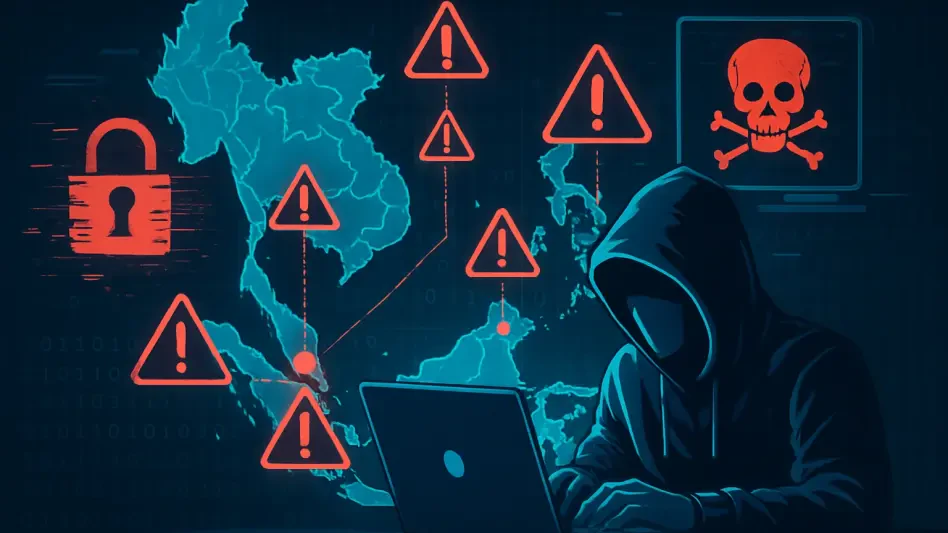In an era where digital transformation shapes economies and societies, Southeast Asia has emerged as a prime target for cybercriminals, grappling with a staggering rate of attacks that nearly doubles the global average. Recent data reveals that organizations in this region face an average of 3,513 multi-vector cyberattacks weekly, compared to a worldwide average of 1,916. This alarming disparity underscores a growing crisis, fueled by rapid digitalization, systemic vulnerabilities, and increasingly sophisticated threat actors. From government institutions to healthcare providers, critical sectors are under siege, with attackers exploiting outdated systems and weak access controls to devastating effect. As the region races to modernize, the question looms: can it build resilient defenses fast enough to counter this relentless wave of digital assaults? This pressing issue demands a closer examination of the unique challenges, emerging threats, and strategic responses needed to safeguard Southeast Asia’s digital future.
Regional Hotspots Under Siege
The cyber threat landscape in Southeast Asia reveals stark disparities, with certain countries bearing a disproportionate burden of attacks. Indonesia stands out as the most heavily targeted nation, enduring an average of 6,640 weekly attacks per organization—more than double the regional average. This includes elevated rates of botnet and ransomware incidents, which exploit gaps in cybersecurity infrastructure. Vietnam follows closely with 5,727 weekly attacks, particularly in government and military sectors, which face an intense barrage. Singapore, despite its advanced digital ecosystem, is not immune, with healthcare and government entities experiencing thousands of attacks each week. Thailand also reports significant pressure on its utilities and public sectors. These figures paint a grim picture of a region where rapid technological adoption often outpaces the implementation of robust security measures, leaving critical industries exposed to persistent and evolving threats.
Beyond individual countries, the targeting of specific sectors across Southeast Asia highlights the strategic intent of cybercriminals. Government and military entities, healthcare organizations, and financial institutions are prime targets due to the high value of their data and the severe consequences of breaches. Weak identity and access controls, combined with outdated systems, create fertile ground for exploitation. The healthcare sector, for instance, faces relentless attacks as personal data becomes a lucrative commodity on the dark web. Similarly, financial institutions grapple with the dual threat of monetary loss and reputational damage. This pattern of targeting reflects a calculated effort to disrupt essential services and erode public trust in digital systems. As attackers refine their methods, the need for region-wide collaboration and sector-specific defenses becomes increasingly urgent to mitigate the cascading effects of these intrusions.
Evolving Threats and Sophisticated Tactics
A defining characteristic of the current cyber threat landscape in Southeast Asia is the growing sophistication of attacks, driven by cutting-edge technologies like artificial intelligence. Threat actors now weaponize AI to create highly convincing phishing campaigns, deepfakes, and synthetic voice attacks that bypass traditional security protocols. These advanced tactics erode trust in digital interactions, making it harder for organizations to distinguish legitimate communications from malicious ones. Additionally, the rise of info-stealer malware marks a troubling trend, as stolen credentials often serve as entry points for larger-scale assaults like ransomware or supply chain breaches. Smaller organizations, often lacking robust cybersecurity frameworks, are particularly vulnerable to these deceptive strategies. This convergence of technology and malice signals a new era of cyber warfare, where the stakes are higher than ever for unprepared entities across the region.
Another alarming development is the shift toward data extortion-first ransomware, a tactic that prioritizes stealing sensitive information over traditional system encryption. Attackers threaten to expose stolen data unless ransoms are paid, placing immense pressure on sectors like healthcare, education, and government, where reputational risks are paramount. This approach exploits the abundance of personal and proprietary data within these industries, amplifying the potential for widespread harm. The collaborative nature of modern cybercriminals further compounds the threat, as they operate within organized ecosystems rather than in isolation. These agile networks exploit gaps in systems, processes, and regulatory frameworks, aiming for long-term compromise rather than short-term disruption. As digital trust becomes a casualty of these coordinated assaults, organizations must rethink their defensive strategies to address both immediate vulnerabilities and systemic weaknesses.
Building Resilient Defenses
Addressing the escalating cyber threats in Southeast Asia requires a fundamental shift from reactive measures to proactive, integrated defenses. Experts advocate for the adoption of multi-layered, AI-powered systems that enhance both prevention and detection capabilities. Such systems are essential for countering the sophisticated tactics employed by modern attackers. Beyond technology, organizations must prioritize visibility across hybrid and multi-cloud environments, ensuring that no access point remains unprotected. Strengthening identity controls, securing application programming interfaces, and implementing zero-trust architectures are critical steps in fortifying digital perimeters. These measures, while resource-intensive, are necessary to keep pace with adversaries who continuously adapt their methods. The focus must be on building a security posture that anticipates threats rather than merely responding to them after the damage is done.
Equally important is the need for cross-industry collaboration and intelligence sharing to foster collective resilience. Cyber threats do not respect organizational or national boundaries, making isolated defenses insufficient against coordinated attacks. By integrating automation, robust data protection, and privacy-by-design principles, organizations can create trusted programs that minimize vulnerabilities. The emphasis on shared knowledge allows for faster identification of emerging threats and the development of unified responses. Additionally, regulatory frameworks must evolve to support these efforts, ensuring that compliance does not hinder innovation but rather reinforces security. As Southeast Asia continues to digitize at a rapid pace, the implementation of these strategies will determine whether the region can safeguard its digital infrastructure against an ever-growing tide of cyberattacks that threaten both economic stability and public trust.
Pathways to a Secure Digital Future
Reflecting on the challenges faced, it becomes evident that Southeast Asia is under an unprecedented level of cyber siege, with attack rates far surpassing global norms. The intensity of threats, particularly in countries like Indonesia and Vietnam, has exposed critical vulnerabilities in key sectors. Sophisticated tactics, including AI-driven deception and data extortion ransomware, have reshaped the battlefield, demanding a reevaluation of traditional defenses. Looking ahead, the focus must shift toward actionable solutions that prioritize prevention over reaction. Investing in advanced technologies, fostering cross-sector partnerships, and embedding security into the fabric of digital transformation are essential next steps. By embracing a proactive mindset and leveraging shared intelligence, the region can build a more resilient digital ecosystem. These efforts will not only mitigate current risks but also lay the groundwork for sustainable growth in an increasingly interconnected world.








